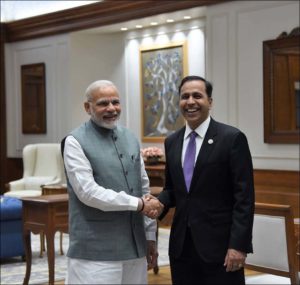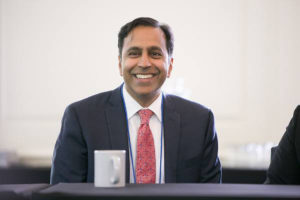
Congressman Raja Krishnamoorthi met India’s Prime Minister (Photo courtesy Raja Krishnamoorthi)
MUMBAI – It used to be said of Chicago, whose suburbs I represent in Congress, that more people of Polish descent lived there than in any area outside of Warsaw. Today, a similar statement could be made about the United States and India. There are more than 4.4 million Indian-Americans, making the United States home to more people of Indian descent than any country except India. Nearly 10 percent of the people I represent in Congress are South Asian or Indian-Americans, and the diversity of races, ethnicities and religions truly makes America great.
The relationship between the United States and India is of particular significance for me as it is the story of my life. I was born in New Delhi and was brought to the United States by my parents when I was an infant. I grew up in the prototypical American city of Peoria, Illinois. I am an American and proudly embrace that identity, but I will never forget the country of my birth where I still have family and a long history and heritage.
The relationship between the U.S. and India is personal for me, for my four fellow Indian-Americans in the U.S. Congress, for the tens of thousands of Indian-Americans in my district, and the millions of Indian-Americans in the U.S. Maintaining and strengthening that relationship is important — not just for Indian-Americans, but for the residents of both countries and for our nation as a whole.
The interests of the two countries are entwined beyond those familial bonds. Trade between the U.S. and India generates $67 billion in economic activity each year — bringing business growth and new jobs to the people of both nations. And because India is one of the fastest growing economies in the world, it presents a huge growth opportunity for both countries — a thriving market for American goods, and the chance for India to benefit from American investment.
It is critical that we grow and strengthen our ties with the world’s growing economies and India is foremost among these partners. Already, the U.S. is India’s largest trading partner, with 13.7 percent of Indian exports coming to the United States. Meanwhile, India is one of the largest U.S. trading partners –ranking eighth-highest overall. India has the second-largest English-speaking population in the world, behind only the United States. The futures of our two peoples is more unified than ever before.
This close connection extends far beyond goods and services. It includes the exchange of people and knowledge in both directions. My father first came to the U.S. in pursuit of a graduate degree in engineering. Today, many Indians come to this country to pursue an education or start a business, such as the tech firms I ran before becoming a Member of Congress. Yet, today we face the challenge of overcoming artificially high immigration barriers posed by an Administration that seems intent on discouraging the exchange of people and knowledge. Congress must protect this valuable exchange of people that greatly benefits both nations, and I am optimistic that a majority of Congress will eventually see the light.
While we must work to maintain and expand our economic ties, there is a deeper foundation to Indian-American friendship: our shared democratic values. The U.S. is the world’s oldest democracy, and India is the world’s largest. Our mutual commitment to liberty, justice, the rule of law and fair elections is the cornerstone of our close relations. With the rise of authoritarian governments in Europe and Asia, the U.S. and India form a bulwark of democratic values that transcends the politics of the moment.
The 21st Century will continue to be defined by partnerships based on shared values and cooperation. And while both India and the U.S. can boast powerful militaries, our real strength comes from our democratic ideals. From Washington to Delhi to Tokyo to Berlin and beyond, the world’s leading democracies must work together in the face of rising intolerance, extremism and violence. Together, the U.S. and India can help lead the way.
Now is not the time for our country to turn away from our allies and partners. We must reach out to those nations that share our democratic heritage and values. That’s why a close U.S. partnership with India is not just the dream of millions of Indian-Americans. It is in the long-term best interests of the entire United States.

Raja Krishnamoorthi | Democrat, represents the 8th Congressional District of Illinois.
Theoretically, the Trump administration’s immigration policy is based on two core principles: upholding the rule of law and promoting a “merit-based” system that’s good for the economy.
So why has the Department of Homeland Security (DHS) just proposed to scrap the International Entrepreneur Rule, a late-Obama program intended to lure the world’s most promising entrepreneurs to create companies and jobs in America rather than elsewhere?
The department doesn’t dispute the lawfulness of the program, whose economic benefit is obvious. (Full disclosure: One of us worked for a Republican president and supports this initiative, and the other worked in the Obama White House to implement it.) It would create as many as 300,000 jobs for U.S. workers, it’s been requested by economic development promoters throughout the heartland, and it’s so “merit-based” that only an estimated 0.00004 percent of the world’s population likely would be eligible.
Oddly, DHS begins its proposal by saying that it “stands by its previous findings that foreign entrepreneurs make substantial and positive contributions to innovation, economic growth, and job creation in the United States” and that “[f]acilitating investment and innovation in the United States is of great importance to our country’s ability to lead and remain competitive in the global marketplace.”
Nevertheless, DHS concludes that the International Entrepreneur Rule must die.
First, DHS argues that since the program isn’t a true visa (which only Congress could create), it doesn’t create sufficient certainty for the entrepreneurs and investors who would rely on it. But presumably those entrepreneurs and investors would be the best judges of that, and they have clamored for this program to be enacted.
Next, DHS argues that while Congress should create a bona fide “startup visa,” in the meantime entrepreneurs should use other longstanding visa pathways to stay in the United States. Of course, the inaction of Congress and the inadequacy of existing visas are precisely why the International Entrepreneur Rule was developed. And if the Trump administration were sincere in its desire to guide entrepreneurs through existing visa options, perhaps it wouldn’t have taken down just such a website early last year.
The final argument is the one that might show us the Trump administration’s real objective: Even though applicant fees would fund the International Entrepreneur Rule, DHS argues it “will not be able to offset the opportunity costs associated with diverting limited agency resources that are needed to meet the current Administration’s priorities.” These priorities include a number of euphemisms for clamping down on legal immigration (“reviewing other existing immigration programs, developing new proposed regulatory changes, and carrying out initiatives to better deter and detect fraud and abuse”).
Let’s review: The administration didn’t claim that the International Entrepreneur Rule is unlawful, or that it will destroy American jobs. The only motivations that ring true are an unwillingness to expend any effort to increase immigration, however modestly, and a desire to stay focused on the administration’s major goal of reducing immigration.
In pursuit of this latter goal, the Trump administration is not waiting for an act of Congress. (A White House-backed proposal to reduce legal immigration garnered only 39 votes in the Senate earlier this year.) Killing the International Entrepreneur Rule is one relatively small item on an aggressive agenda to deter legal immigrants across the board. Federal agencies have already moved to , ramp up denials of skilled worker visas, and all but eliminate refugee admissions.
Next up? Preventing gainful employment for up to 100,000 spouses of H-1B workers (predominantly educated Indian women), curtailing post-graduate training for foreign students with science and engineering degrees, and curbing Chinese student visas. Plus a sweeping new policy to deny green cards to immigrants who used nearly any government benefit over the past several years — or are deemed likely to do so in the future. Departing from a century of precedent, this one regulation could impede millions of immigrants from providing for their U.S. citizen children, block U.S. citizens from sponsoring their parents for green cards and even result in the deportation of lawful permanent residents who have committed no crimes.
For generations, presidents of both parties have welcomed legal immigrants to America’s shores, understanding that our nation’s vitality, growth and heritage depend on newcomers with drive, skills and a willingness to sacrifice for their family’s future. The administration’s efforts to unravel those welcoming policies have only just begun.
Leave Comments